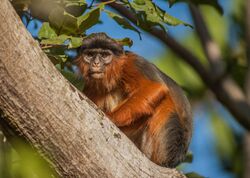Biology:Temminck's red colobus
| Temminck's red colobus[1] | |
|---|---|

| |
| Scientific classification | |
| Domain: | Eukaryota |
| Kingdom: | Animalia |
| Phylum: | Chordata |
| Class: | Mammalia |
| Order: | Primates |
| Suborder: | Haplorhini |
| Infraorder: | Simiiformes |
| Family: | Cercopithecidae |
| Genus: | Piliocolobus |
| Species: | |
| Subspecies: | P. b. temminckii
|
| Trinomial name | |
| Piliocolobus badius temminckii (Kuhl, 1820)
| |

| |
| Temmick's red colobus range shown in yellow | |
| Synonyms | |
|
Piliocolobus temminckii | |
Temminck's red colobus (Piliocolobus badius temminckii) is a type of red colobus monkey from the Gambia, Casamance, Guinea-Bissau and northwestern Guinea. It has historically been regarded as a subspecies of the western red colobus (Piliocolobus badius),[1] and the Integrated Taxonomic Information System and Mammal Diversity Database both maintain this classification,[3][4] but many less recent taxonomies classify it as a separate species (Piliocolobus temminckii).[5][6]
Temminck's red colobus generally lives in dry deciduous and gallery forests. In Senegal it also lives in savannah.[5] No other red colobus lives in savannah.[5] The use of savannah and open areas may be a recent adaptation to deforestation, since researchers in the 1970s always found Temminck's red colobus in tall, dense forest.[5] Temminck's red colobus living in savannahs often associate with green monkeys, and sometimes also associate with patas monkeys and bushbucks for defense against predators.[5][7] Temminck's red colobus differs from the Western red colobus in that the Western red colobus lives in rainforest rather than dry forest and savannah, which may explain differences in behavior.[6]
The majority of its diet consists of fruit and leaves. Seeds, flowers, buds, bark and nuts account for most of the rest of the diet.[7]
Temminck's red colobus is listed as endangered on the IUCN Red List of Threatened Species.[2] Primary threats include deforestation and hunting.[7]
References
- ↑ 1.0 1.1 Groves, C.P. (2005). Wilson, D.E.; Reeder, D.M.. eds. Mammal Species of the World: A Taxonomic and Geographic Reference (3rd ed.). Baltimore: Johns Hopkins University Press. p. 169. ISBN 0-801-88221-4. OCLC 62265494. http://www.departments.bucknell.edu/biology/resources/msw3/browse.asp?id=12100621.
- ↑ 2.0 2.1 Minhós, T.; Ferreira da Silva, M.J.; Bersacola, E.; Galat, G.; Galat-Luong, A.; Mayhew, M.; Starin, E.D. (2020). "Piliocolobus badius ssp. temminckii". IUCN Red List of Threatened Species 2020: e.T18247A92648587. doi:10.2305/IUCN.UK.2020-1.RLTS.T18247A92648587.en. https://www.iucnredlist.org/species/18247/92648587. Retrieved 12 November 2021.
- ↑ "Piliocolobus badius temminckii". Integrated Taxonomic Information System. https://www.itis.gov/servlet/SingleRpt/SingleRpt?search_topic=TSN&search_value=945544#null.
- ↑ "Piliocolobus badius (Kerr, 1792)". American Society of Mammalogists. http://www.mammaldiversity.org/explore.html#species-id=1000641.
- ↑ 5.0 5.1 5.2 5.3 5.4 Zinner, D.; Fickenscher, G.H.; Roos, C. (2013). Mittermeier, Russell A.. ed. Handbook of the Mammals of the World: Volume 3, Primates. Lynx. pp. 705–706. ISBN 978-8496553897.
- ↑ 6.0 6.1 Groves, C.P. (2016). "Species concepts and conservation". in Wich, Serge A.. An Introduction to Primate Conservation. pp. 45–47. ISBN 9780198703396.
- ↑ 7.0 7.1 7.2 Galat-Luong, A. (2016). Rowe, Noel. ed. All the World's Primates. Pogonias Press. pp. 547–549. ISBN 9781940496061.
Wikidata ☰ {{{from}}} entry
 |



